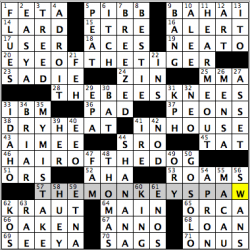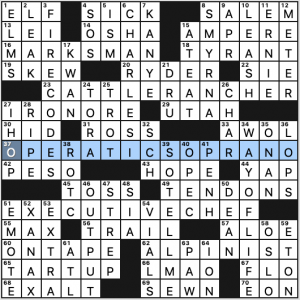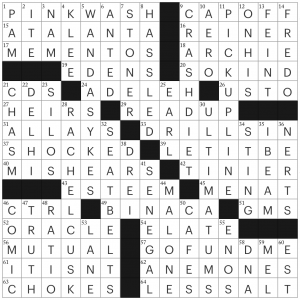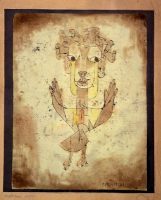Michael Schlossberg’s New York Times crossword —Ade’s take

Michael Schlossberg’s New York Times Crossword Puzzle solution, 02.03.20
Hello there, everybody! Ade stepping into this space for the day, and hope you all are ready for the start of another week!
Today’s grid, brought to us by Mr. Michael Schlossberg, deals with animal anatomy…while not dealing with animal anatomy at the same time! Each of the theme answers is a title or a phrase that ends up containing both the name of an animal and a body part in it.
- EYE OF THE TIGER (20A: [Theme song for “Rocky III”]) – No matter where I am, I feel like shadowboxing while jogging every time the opening riff plays on my iPhone.
- THE BEE’S KNEES (28A: [Height of excellence, metaphorically])
- HAIR OF THE DOG (46A: [Hangover remedy in which one continues drinking])
- THE MONKEY’S PAW (57A: [Classic horror tale by W. W. Jacobs]) – I’ll pass on those three wishes, thank you very much!
Happy to have BREEZED through this grid with no hiccups to report (7D: [Glided effortlessly (through)]). A couple of Asia-related entries could have caused some slippage in the solving, whether putting in “Islam” instead of BAHA’I (9A: [World faith founded in Persia]) and/or putting in the alternate spelling of MACAU, Macao (55D: [Chinese region dubbed the “Vegas of Asia.”]). Loved the fresh fill of both BESTIE (8D: [Favoritest friend]) and HEAR ME OUT (11D: [“I know you think this is a ludicrous idea, but…”]). Probably favorite fill of the day was actually IN-HOUSE (41A: [Not outsourced]). A number of three-letter crosswordese might have been a eyesore, especially with FEH featured, but who am I to get upset at some Yiddish being mentioned in the grid (21D: [“Bah!”]). Kansas City has just won the Super Bowl, 50 years after appearing in and winning the Big Game last. In honor of the win, let’s talk about one of the greatest players to ever play for the franchise, one who was a big part of the 1969-70 championship team that won the last game played before the AFL-NFL merger.
“Sports will make you smarter” moment of the day: THOMAS (48D: [Supreme Court justice Clarence]) – Former Kansas City pro football player Emmitt Thomas was one of the great defensive backs in pro football during his playing days in the late 1960s and 1970s. Like many of the stars that the upstart American Football League brought in during the 1960s, Thomas played at an HBCU, the now defunct Bishop College in Marshall, Tex. Thomas was a five-time Pro Bowler and, in Kansas City’s Super Bowl-winning season of 1969, he led all of pro football in interceptions with nine. Thomas became a longtime coach and coordinator in football after his playing days were over and, eventually, was inducted into the Pro Football Hall of Fame in 2008.
Thank you so much for your time once again, and have a great rest of your Monday!
Take care!
Ade/AOK
Adam Aaronson & Joey Swidler’s Wall Street Journal crossword, “Dynamic Range”—Jim P’s review
It looks like we have two WSJ debuts today, so congratulations are in order. Mr. Aaronson had his NYT debut just about a month ago with a nice Saturday grid.
The clue [Range master] takes on different meanings in each of our theme answers today.
- 16a MARKSMAN. Rifle range.
- 23a CATTLE RANCHER. “Home on the range” range.
- 37a OPERATIC SOPRANO. Vocal range.
- 51a EXECUTIVE CHEF. Cooking range.
- 62a ALPINIST. Mountain range.
A nice set, although OPERATIC SOPRANO feels a little bit on the edge of in-the-language phrases. Still, for the purposes of the puzzle, and since it’s a nice grid-spanner, I don’t really have a problem with it. Does a soprano have a greater range than any of the other voice types?
Top fill: “SO TELL ME…,” WAY OF LIFE, FIRE CODES, LMAO, TYRANT, and CHARLES I [King during the English Civil War]. I guessed CHARLES V, but silly me, there have only been two Kings Charles of England…so far. If you were hoping for a quick English Civil War recap in a West Side Story-style dance off, you’re in luck. See the Horrible Histories video below (note: the audio sync is a little off).
I’d never heard of SMYRNA [Georgia city named after a Greek city of Anatolia] (either one), but everything else was Monday smooth.
One clue of note:
- 8a. [House of the Seven Gables location]. SALEM. When I see the word “gables,” I think of the stepped gables of Europe (specifically Bruges, Belgium). Since I’ve never read the Nathaniel Hawthorne book, I was surprised at this answer.
And that’s all I’ve got. A nice, accessible Monday grid with just a touch of good wordplay. 3.75 stars.
Anna Shectman’s New Yorker crossword – Rachel’s writeup
Interesting grid design! The line of black squares down the middle means we have essentially two puzzles, which only connect in two squares. Fortunately, those squares are both quite gettable, belonging to long downs WANDA SYKES and ULTIMATUMS. The other long downs are RACHEL CUSK, who I did not know, and PICKUP LINE, which I wrote in cold with no other squares in the NE, and which felt like a missed opportunity to clue with a really *wild* PICKUP LINE.
I enjoyed the solve on this puzzle, although I think the overall excitement level of some of these entries is a bit on the low end (relative to other recent New Yorkers; relative to other puzzles, this still packs a punch!). This puzzle’s real shine is in the cluing, which is full of that trademark New Yorker cultural trivia. Some examples:
- Director of “The Princess Bride” (REINER) – love the movie, had no idea who directed it
- Début album by SZA that went platinum (CTRL) – knew this one!
- It has raised more than five billion dollars since its 2010 launch (GO FUND ME) – !!!!!
- “Angelus Novus” artist (KLEE) – see picture
- They’re legally required for adults in every state except New Hampshire (SEATBELTS) – fun fact!
Some other things:
- A few entries I loved: PINKWASH, NERTS, ANEMONES (which I struggled to spell).
- What on earth is BINACA? I mean, don’t tell me, I can google it, but it was eminently uninferrable.
- Fill I could live without: ON HIS/US TO/ITE/IT ISN’T/ MEN AT/SO KIND (and don’t get me wrong, I *love* Natalie Merchant, but this is an odd partial).
- Names I didn’t know: RACHEL CUSK, Léopold Sédar Senghor
- A brief rant about CRISPR, because I am a bioethicist (and this has absolutely nothing to do with the puzzle, except that CRISPR was in a clue): CRISPR is cool! Editing DNA is very interesting and exciting, etc etc, but I wish we would expend even half the resources we use to research CRISPR on researching how better to distribute *existing* solutions for *existing* problems that are *currently* unfairly distributed (and that bioethicists could be incentivized to work on such things rather than, or in addition to, every shiny new technology that comes along. LOOKING AT YOU, NIH.). Anyways.
Overall, this was a fun solve and I learned a bunch, which is always worth at least one bonus star. Several stars from me!
David Poole’s Los Angeles Times crossword—Nate’s write-up

LAT 2.3.20 Solution
17A: WHEELMAN [Getaway car driver]
26A: HOLE IN ONE [Golfer’s dream]
37A: POINT OF NO RETURN [You can’t go back after passing it]
51A: BALL OF WAX [Kit and caboodle]
62A: PINHEADS [Tops of sewing fasteners … and what the starts of 17-, 26-, 37- and 51-Across can have]
The first part of each themer can be followed by pin: pinwheel, pinhole, pinpoint, and pinball. Not bad for a Monday puzzle, except that it feels like this exact puzzle could have been published a decade ago or more with only a few slight clue changes. That bums me out because I want to bring in and engage new generations of solvers, and part of that requires puzzles whose language is current and references are more modern. It also bums me out that one of the few women in the grid (Yoko ONO) is only clued as the love interest of a man, even though she’s significantly accomplished in her own right. This isn’t saying that the puzzle wasn’t a nice solve on a Monday – just that I felt like I’d time warped to the early 2000s to solve it.



I enjoyed the solve of the WSJ, a great example of (to me) how much more fun early week puzzles from Shenk are than from Shortz. (Say that last phrase quickly three times …)
New Yorker – very very New Yorker although BINACA is truly an #OKBoomer moment.
NYT – felt like a good croswordese 101 tool. Zoom, indeed. It also reminded me of how many bartenders have no idea how to make my wife a Bee’s Knees.
Condolences to my wife’s family on the 49er loss, she & I don’t watch Am. Football except with them.
More #OKBoomer, I got a great laugh out of Cheetos Popcorn HammerTime.
My reaction to CRISPR in the NYer was much more prosaic: the clue doesn’t really work because I can’t see how you can construe DNA as a “unit.” DNA is the molecule in a general sense. CRISPR manipulates little stretches of DNA. But you can’t say “a DNA.”
Also, I can’t imagine anyone saying that they would DRILL IN a bolt.
Good puzzle apart from those two bits of nitpicking. RACHEL CUSK is an extraordinarily good writer, but what I’ve read of hers has been grim and depressing.
BEQ: “A battery” is a real blast from the past for some of us and probably a head-scratcher for everyone else. It’s from those pre-transistor days when portable radios used tubes. They had A and B batteries, and sometimes C’s. But these designations had nothing to do with A, AA, C, D, etc. cells. They described the functions of the batteries, not their size.
The A battery was low voltage (like a 1.5-volt cell) that lit the tubes’ filaments (my first entry), which was the element that glowed. These batteries tended to wear out quickly because the tubes generated a lot of wasted heat. The B battery was a high-voltage (and big) battery — perhaps 90 volts — that provided cathode voltage. Tubes also had elements called grids that actually controlled how much current the tube passed. Sometimes the grids needed a constant “bias” voltage, which was the job of the C battery. (In many designs the B battery provided bias voltage too. )
All of these batteries made for a very heavy portable, but you couldn’t be cool at the beach in the fifties without one. And they also didn’t last very long. You had to pay for cool.